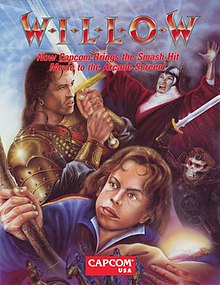Willow (Capcom arcade game)
Willow[lower-alpha 1] is a 1989 arcade game by Capcom. Capcom published two different games in 1989 based on the 1988 film of the same name.[2][3][4] The arcade version is a platform game while the Nintendo Entertainment System version is an action-RPG.
| Willow | |
|---|---|
 | |
| Developer(s) | Capcom |
| Publisher(s) | Capcom |
| Director(s) | Yoshiki Okamoto |
| Designer(s) | Hiroyuki Kawano Seigo Ito |
| Programmer(s) | Kyoko Tomita Yukio Arai |
| Artist(s) | Akemi Kurihara Franky Sezabon M. Okazaki |
| Composer(s) | Takashi Tateishi |
| Series | Willow |
| Platform(s) | Arcade |
| Release | |
| Genre(s) | Action, platform |
| Mode(s) | |
| Cabinet | Upright |
| Arcade system | CP System |
Gameplay
.png)
The arcade version of the game belongs to the platform genre. It has six stages, some where Willow plays his part, others where Madmartigan plays his and one of the stages where either character is selectable. The stages consist of Crossroad, Cherlindrea's Forest, Fin Raziel's Island, Sorsha's Camp, Tir Asleen Castle, and Nockmaar Castle. Each stage must be completed within a certain amount of time. Defeated enemies drop coins which the player can collect to buy things at shops. Depending on whether the player is playing as Willow or Madmartigan, either magic blasts or sword swipes are the attacks. Madmartigan's attack has less range than Willow's, but can destroy enemy projectiles. Both can purchase attack upgrades at shops. Madmartigan's upgrades give him greater power and range, while Willow's upgrades are far more versatile. With each upgrade, his regular blasts become more powerful, the actual upgrades being utilized by holding down the attack button and releasing it when the meter at the screen's bottom reaches a certain point. The following are his magical upgrades:
1. Moonlight - sends a crescent shaped blast forward, which splits into smaller beams on impact, damaging enemies in its path.
2. Tornado - sends a tornado shaped blast forward and at a slightly upward angle.
3. Gold - defeats most on-screen regular enemies; the coins they drop are worth twice their normal value.
4. Time - freezes all regular enemies and their projectiles for a few seconds, during which time Willow is invincible (he flashes blue).
5. Explosive - sends cascades of blasts to both forward and back of Willow.
6. Crystal - sends a circular barrier around Willow, damaging enemies in its path; this is the only of Willow's magic that can destroy projectiles.
Plot
The evil witch queen Bavmorda is after the holy baby of the lands, Elora Danan, intent on destroying her. A young peaceful wizard called Willow Ufgood was selected to protect Elora. Later on, a brave warrior named Madmartigan joins Willow to fight the enemy rival General Kael.
Development and release
Capcom director Yoshiki Okamoto commented that the game was part of a broader strategy of Capcom at the time to appeal to a wider audience by using established characters from other media, as their original characters could be too niche.[5] In addition to Willow, he cited games based on Area 88 and Destiny of an Emperor as part of this strategy.[5] Capcom developed two games based on Willow in 1989.[2] The arcade game plays similar to Capcom's previous fantasy action platformer Ghouls n' Ghosts.[4] The Willow game developed for the NES is a role playing game.[2][4]
Reception
| Reception | ||||||||||||||||||||
|---|---|---|---|---|---|---|---|---|---|---|---|---|---|---|---|---|---|---|---|---|
| ||||||||||||||||||||
Willow was well received by critics since its release in arcades.[2] In Japan, Game Machine listed Willow on their July 15, 1989 issue as being the second most-successful table arcade unit of the year, outperforming titles like Gang Wars and Golden Axe.[14]
Notes
References
- Akagi, Masumi (13 October 2006). カプコン Capcom; Capcom USA (Capcom Coin-Op); W. アーケードTVゲームリスト 国内•海外編 (1971-2005) (in Japanese) (1st ed.). Amusement News Agency. pp. 23, 112, 171. ISBN 978-4990251215.
- Sanz, Juan Carlos (February 1999). "Sala de máquinas - Willow". Superjuegos (in Spanish). No. 82. Grupo Zeta. pp. 118–121.
- "Super Soft Corner: ビデオゲーム新作インフォメーション - ウィロー". Micom BASIC Magazine (in Japanese). No. 82. The Dempa Shimbunsha Corporation. July 1989. p. 268.
- "The Unconverted: Capcom Special - Willow". Retro Gamer. No. 123. Imagine Publishing. December 2013. p. 82.
- Ishii, Zenji; Suzuki, GOD (November 1989). "カプコン開発者インタビュー". Gamest (in Japanese). No. 38. Shinseisha. pp. 10–12. (Translation by Shmuplations. Archived 2017-05-31 at the Wayback Machine).
- Baize, Anthony (1998). "Willow (Arcade) - Review". AllGame. All Media Network. Archived from the original on 2014-11-16. Retrieved 2020-06-22.
- "Arcade Action - Willow". Computer and Video Games. No. 93. EMAP. August 1989. pp. 86–87.
- "Arcade Ace - Willow (Capcom)". ACE. No. 24. EMAP. September 1989. p. 23.
- "Arcades: Capcom - Willow". Commodore User. No. 71. EMAP. August 1989. pp. 84–85.
- "Sous Les Arcades: Willow (Capcom)". Génération 4 (in French). No. 15. Computec Media France. October 1989. pp. 56–57.
- "Coin Ops - Willow (Capcom)". Sinclair User. No. 90. EMAP. September 1989. p. 74.
- Bielby, Matt (September 1989). "Slots Of Fun: Dune's Corky Coin-Op - Willow". Your Sinclair. No. 45. Dennis Publishing. p. 70.
- Bielby, Matt (November 1989). "Dosh Eaters: Willow (Cap Com/30p a go)". Zero. No. 1. Dennis Publishing. p. 87.
- "Game Machine's Best Hit Games 25 - テーブル型TVゲーム機 (Table Videos)". Game Machine (in Japanese). No. 360. Amusement Press, Inc. 15 July 1989. p. 33.
External links
- Willow at GameFAQs
- Willow at Giant Bomb
- Willow at Killer List of Videogames
- Willow at MobyGames